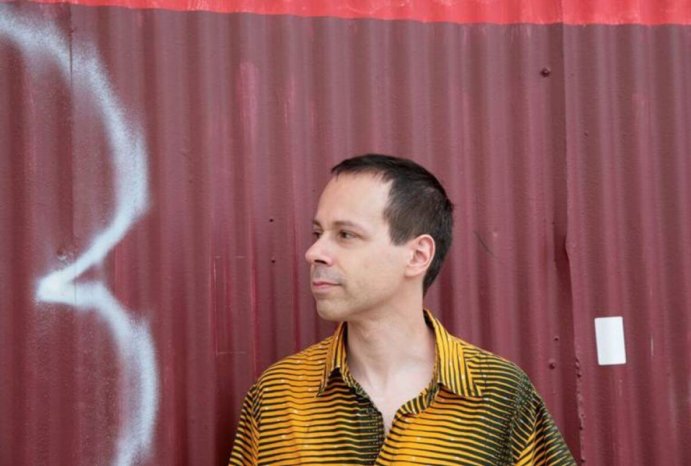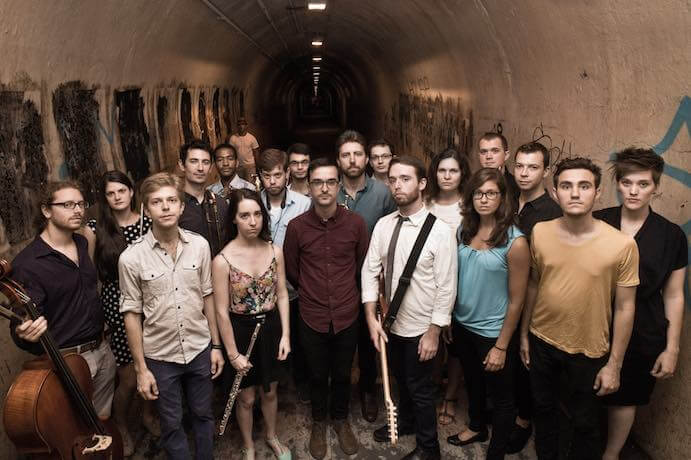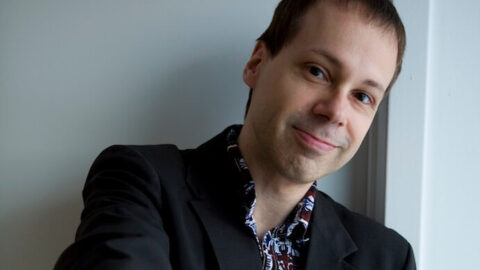On Sunday, August 14, 2016, National Sawdust presented the music of Austrian/Hungarian/American composer and percussionist Lukas Ligeti, performed with youthful verve by one of New York’s most exciting emerging ensembles, Contemporaneous. National Sawdust opened its doors in the Fall of 2015, quickly establishing itself as the preeminent presenter and resource for an eclectic diversity of downtown and contemporary concert music composers and performers. Contemporaneous-cum-Ligeti articulately represented the venue’s mission in a program entitled “Influences/Confluences,” which drew upon the composer’s experiences growing up in Vienna surrounded by cross-disciplinary inspiration; most notably [Bauhaus] architecture and dissolving into abstractions described in no great detail by the composer as “geometric shapes and visual illusions.”
The program opened with a sparse and delicate work for violin and piano duet called Excerpts from Time” performed by Contemporaneous members Josh Henderson (violin) and Milena Gligic (piano). Noted by the composer as one of his first compositions, the piece expresses a kind of Hungarian-ness with its rambling chromatic lines woven carefully into a lattice of sparkling textures from the piano. At times it played like Bach and others Bartok, and felt well aligned with the concept of cultural inspection declared by the program.

The following work, language: PROUN, was the evening’s world premiere and called to the stage a quintet including soprano Ariadne Greif, violinist Kate Dreyfuss, cellist Amanda Gookin, trombonist Daniel Linden and percussionist Matt Evans, exclusively at the vibraphone. The work, commissioned by the Balassi Institute with text by Lajos Kassák, was highly conceptual, exploring the rhythms of normal speech patterns with the soprano acting as conductor and pushing the ensemble along as she vocalized the text. Unfortunately, the work came across as rather dated, modern only in an anachronistic or historical sense. Finely crafted, Ligeti’s knack for orchestration was illuminated by the skill and shrewd focus of the players, making the piece enjoyable to hear but ultimately could not overcome the derivative nature of the material.
Thinking Songs for marimba solo is a substantial work composed over the course of ten years from 2005-2015. As a unit, the five movements of Thinking Songs suggest a cinematic underscore, easily conjuring images of characters in a film pensively solving a mystery from within the shadowy stacks of an ancient library, or sailing on a melancholy voyage over undulating waves on an ominous sea. As a concert work, however, the length and homogeny proved to be inapt challenges. It is perhaps too basic to suggest that the monotonous timbre of the marimba makes it hard to distinguish one piece from another, but in the wash of muted, wooden tones there was little that stood out despite percussionist Ji Hye Jung’s great skill and energetic playing. While it is equally precarious and no less subjective to claim that the use of extended techniques will inherently bring a sense of uniqueness to a work, it was in those moments that the instrument was enhanced with small objects, cymbals, bells and wooden shakers that the droning, velvet textures were shaken up, like a break in the clouds, and clearer sense of evolution and direction shone through.

The final pieces of the program pulled together configurations of ensemble Contemporaneous for fourteen and fifteen players, conducted by co-artistic director David Bloom. According to the composer, Surroundedness for fourteen players was influenced by the “idea of frequency modulation [as in] radio transmission and electronic music synthesis.” Adapted into material for a live ensemble, the work draws its thread through “tightly-knit contrapuntal bands” that creates a nebulous haze of oscillating frequencies, which come into focus upon closer listening.
Curtain for fifteen players offered perhaps the most focused connection between Ligeti’s compositions and the interdisciplinary basis underlying their inspiration as articulated in his program notes. Inspired by visual works such as William Kentridge’s animations, brought to life by erasing and drawing over previous drawings on the same surface, Curtain is a so-called “anti-concerto” in which the central string quartet is constantly in peril of being eclipsed by the larger group, rather than showcased by emerging from the established material.
Under Bloom’s skilled hand, the ensemble continued to flourish and maintained a shimmering energy and precision through these final works. True to its name, Contemporaneous exhibited a fresh and youthful contemporary vibe, staying ahead of a pervasive specter of an antiquarian modernism conveyed by much of the evening’s material. Strong attendance on a Sunday night (the hall appeared to have been sold out) offered further confirmation that National Sawdust has arranged a successful constellation of support, forecasting stability into this exciting, young venue’s second season and ongoing future.
























